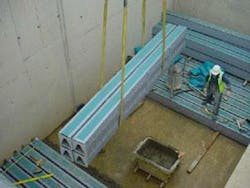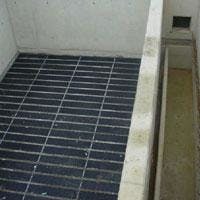Gravity filter design changes save construction costs
By Thomas M. Getting
Improved filter designs, including flat bottom flume and gravelless porous plate technologies, are reducing construction and operational costs for water treatment plants in the United Kingdom and the USA.
The flat bottom flume eliminates the need for separate air header piping and the need to excavate the recess for the lower backwash flume - two common requirements of filter design. Constructing a flat level floor for the filter box and eliminating costly stainless steel reduces installed construction costs.
The flow of backwash water and air must be made available to each lateral in order to provide a uniform backwash. Original designs provided the distribution of the backwash water and air by feeding them separately in different conduits. The flat bottom flume accomplishes this in the flume area with two air/water interfaces, one located behind the baffle wall and the other at the level of the lateral feeds. Backwash water is introduced into the end of the flume behind the baffle wall. The backwash water is then metered through orifices in the invert of the baffle wall. The backwash air is introduced into the top of the flume and passes over the baffle wall. Between the baffle wall and the flume wall, the backwash water interfaces with the air as they are metered through another orifice into the end of each dual parallel lateral. This design eliminates air header piping and the recessed flume required by other designs. It also eliminates the need for a deep plenum that assures uniform backwash water distribution required by some systems.
The gravelless porous plate was developed over ten years ago to replace gravel support systems and gain up to 320 mm or more of filter depth for either additional media or to reduce the depth of the filter box. Porous plates are usually manufactured with high-density polyethylene beads that are sintered together to form a flat surface. The flat surface enables the quick change of media such as granular activated carbon.
The flat bottom flume was first used in a water treatment plant in Bessemer, Alabama, USA to save space and construction costs. Operating for one year, the plant conventionally treats up to 91 Ml/d of surface water using alum addition, flash mixing, rectangular clarification and filtration. The filters operate at 9.8 m/hr and consistently produce filtered water with turbidity less than 0.1 NTU. The media consists of 380 mm of sand and 380 mm of anthracite. The filter box was designed with enough depth for the future addition of granular activated carbon. Gravelless porous plate was chosen to simplify the change out to granular activated carbon.
Several other facilities under design or construction have chosen the flat bottom filter configuration. One of them is the Thames Water facility, Swinford Water Works, located in Oxford, UK, which treats surface water using pre-ozone and dissolved air flotation prior to flat bottom filters. Other US facilities under construction using the flat bottom flume are Denton, Texas; Fort Worth, Texas; Madison, Alabama; and Tampa Bay, Florida.
Author's note
Thomas M. Getting, P.E., DEE, is the filtration product manager for F. B. Leopold Company Inc., based in Zelienople, Pennsylvania, USA.


